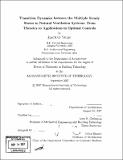Transition dynamics between the multiple steady states in natural ventilation systems : from theories to applications in optimal controls
Author(s)
Yuan, Jinchao
DownloadFull printable version (35.70Mb)
Other Contributors
Massachusetts Institute of Technology. Dept. of Architecture.
Advisor
Leon R. Glicksman.
Terms of use
Metadata
Show full item recordAbstract
In this study, we investigated the multiple steady state behavior, an important observation in numerical and experimental studies in natural ventilation systems. The-oretical models are developed and their applications in numerical simulations and ventilation controls are presented. In a system with multiple steady states, how the system reaches different steady states is determined by the initial values of the systems and the dynamical system characteristics of the system. Mathematical models are developed to model the dynamical system behavior of a series of ventilation systems, ranging from simple single-zone systems to complex systems with thermal mass. More importantly, we found that the system can transform from one steady state to another under sufficient perturbations (disturbances) when multiple steady states exist. A successful transition is determined by both the magnitudes and durations of the perturbations. The transition dynamics are found to be important in theoretical, computational, and control applications. For example, the actual stability of a mathematically (or locally) stable steady state is highly correlated to the minimum perturbation requirements for a state transition. If two indicative parameters-the minimum perturbation time and the minimum perturbation magnitude-are small for the system to transit from one steady state to another, a mathematically stable steady state can be unstable in actual conditions, where stochastic disturbances exist as "strong perturbations". Further, building thermal mass is also found to have significant impacts on the state transitions between the multiple steady states. With thermal mass, the state transition becomes more difficult to occur. The state transition dynamics can also be applied to numerical simulations. (cont.) We have developed a convenient dynamical simulation method to identify the possible steady states in buildings with complex geometries and test the stabilities of the obtained steady states. The method can determine nearly all the possible steady state the system may reach in a feasible range using different search methods; whether the steady states obtained are stable in an actual environment can also be determined by a disturbance test based on the transition dynamics between the multiple steady states.Further, the state transition dynamics can be strategically applied in hybrid ventilation controls. In the past, designers and engineers have viewed the multiple steady states as negative aspect of ventilation design and have been trying to avoid the multiple steady states as much as possible. In this study, we have developed positive applications of multiple steady states based on a dynamic state transition in real-time to enhance the ventilation efficiency of a hybrid ventilation system and to reduce the energy usage in buildings. A coupled multi-zone airflow and thermal program for transient entire building simulations is also developed in parallel with the study. With the understanding on the multiple steady state issues, the developed program has overcome a few non-trivial numerical problems reported in other similar simulation programs and has shown good numerical performance in coupled airflow and thermal analysis. The program is also used as a tool for identifying the multiple steady states in buildings with complex geometries and for testing the actual stabilities of the obtained steady states in real conditions.
Description
Thesis (Ph. D.)--Massachusetts Institute of Technology, Dept. of Architecture, 2007. Includes bibliographical references (p. 269-274).
Date issued
2007Department
Massachusetts Institute of Technology. Department of ArchitecturePublisher
Massachusetts Institute of Technology
Keywords
Architecture.